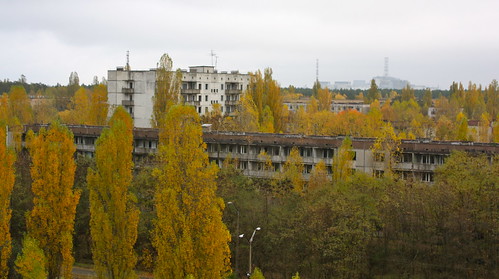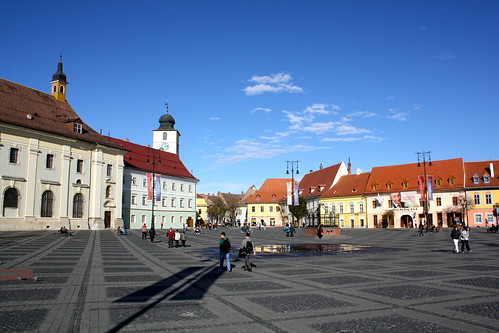Guest post by Julio Moreno:
"I wish I had done this differently."
"Man, I would have totally skipped that if I had to do it again."
Sound familiar? Travel, like pretty much everything in our lives, suffers from 20-20 hindsight. No matter how much you plan, research, and get tips from your friends, the reality is always at least a little different from those early research stages. Some places turn out to be tourist traps and others unexpectedly wonderful places. So why do so few of us go do the same thing twice? It is that wonder, that excitement of doing something the first time that is so amazing, it can't be replicated, no matter how hard you try.
Like any sane person with a healthy dose of wanderlust, I too dream of some day exploring Eastern Europe. Will it live up to expectations? I don't know. Will it exceed them? I hope so. But, like everything that is worth while, it all starts with a dream.
These are 7 places in Eastern Europe that spring into my head when the lights go off and I start dozing off....
 1. Chernobyl, Ukraine
1. Chernobyl, Ukraine
In 1986, not to far from the capital city of Kiev, the largest nuclear disaster in recorded history occurred. One of the reactors in the plant overloaded releasing incredible amounts of radiation to the air, rivers, and land in the surrounding area. What most people don't know though, is that as of 2011, it is now open to the public. Put on your radiation suit and come aboard, this is one tour like no other (figuratively of course, you don’t actually need a suit to visit as your stay will be too short term to cause damage).
Following the disaster, a radius of 30 km around Chernobyl was evacuated, leading to a modern day ghost town. In a little under 30 years, wildlife has once again taken over with overgrowth ripping through concrete in what looks like a post apocalyptic movie.
What makes Chernobyl so unique? It is the significance of the disaster that to me, is amazing. When the global warming debate comes up, one of the biggest skeptic arguments is that we humans must be delusional to think we can affect the earth in such a grand scale. Well, here is Chernobyl, which is by our own hand, uninhabitable for the next 20,000 years, according to some experts. [Francis comment: Given that babushkas are living there now, it's unclear what these "experts" are really saying.]
2. Auschwitz, Poland
Auschwitz, for those of us who have never picked up a history book, was THE Nazi extermination camp during WW2. Pretty much every terrible thing you have ever heard about the Nazis can be summed up with the atrocities that occurred in Auschwitz. It is that historical enrichment that makes this site so fascinating.
The Nazi war machine changed the rules of the game. For all of time before WW2, wars were fought for land, economic benefit, or simple pride. Germany took it to an extreme as it attempted to wipe out the Jewish population from the face of the earth. That is not the scary part. The scary part is that the rest of the world stood by and did nothing until it was almost too late.
Auschwitz, it is my hope, will teach me not just that racism and genocide is wrong (come on, who DOESN'T know that) but that we as fellow human beings have a social responsibility to do something about it.
 3. Transylvania, Romania
3. Transylvania, Romania
As far as mythical creatures go, there are few that we are as fascinated with as we are with vampires. There are countless tales, movies, TV series, and novels dedicated to the idea that there might be these people who look human, but in fact feed on our blood!
Now, I am not really a Twilight fan nor did I grow up with Buffy the Vampire Slayer dolls, but I do find the historical area of Transylvania interesting. I know that the odds of finding a vampire are slim, but how many leads do you have leading towards immortality? None? Didn't think so.
4. Moscow, Russia
While Russia doesn't make too many bucket lists out there, its architecture alone is reason enough to put it in the conversation. If you see St Basil's Cathedral in any picture, you automatically know it is in Russia and for good reason, there is nothing else like it.
Another amazing Moscow fact is that it links up with the Trans-Siberian Railroad. The legendary railway linked up Europe to the mostly frozen lands of Siberia. Despite many people still thinking of this area as desolate and wild, the railroad opened up the doors for people to migrate east where there were cheap lands. Millions decided that the threat of Antarctica-like weather was worth the cheap land and you have this railroad to thank for it.
A trip across Russia wouldn't be easy, and I imagine, would also not be the most action packed thing in the world. However, for those adventurers out there, this is a trip of a lifetime.
5. Transnistria
How many countries are in the world? If you looked it up and said 193 (as recognized by the UN), then you are not counting Taiwan? They have passports, citizens, international borders, a military, and regularly trade with the outside world. As you can see, answering this question is harder than it sounds.
In comes Transnistria, a breakaway territory in Moldova. While it is not recognized by the UN, it has its own borders, police force, and even prints passports (although no one but Russia seems to accept them). Ignoring the fact that this state exists could get you killed, as tensions are high between Transnistria, Ukraine, and Moldova, making the punishment for many crimes, death by instant execution.
Having grown up in the US, and living most of my adult life in the homogenous country of South Korea, I won't pretend to understand the cultural, historical, or political divides of Eastern Europe. It is that very lack of knowledge however, that makes places like this so incredible.
Oh yeah, and did I mention Transnistria is a Soviet Republic?
6. Acropolis of Athens, Greece
 Yes yes, it is common, but no less significant. The Acropolis of Athens is one of the oldest signs of civilization and consequently, human intelligence. It holds ancient Greek buildings with the most famous being the Parthenon, one of the most visited sites on earth. The accomplishments of the ancient Greeks are very well documented, but nonetheless, it is something of a minor miracle that anything this old could remain standing more than two thousand years. Greece might not be doing too hot now, but here goes some love to the civilization that brought us democracy, and weird paganism.
Yes yes, it is common, but no less significant. The Acropolis of Athens is one of the oldest signs of civilization and consequently, human intelligence. It holds ancient Greek buildings with the most famous being the Parthenon, one of the most visited sites on earth. The accomplishments of the ancient Greeks are very well documented, but nonetheless, it is something of a minor miracle that anything this old could remain standing more than two thousand years. Greece might not be doing too hot now, but here goes some love to the civilization that brought us democracy, and weird paganism.
7. Istanbul, Turkey
So, where exactly is Turkey? Is it part of the Middle East, or Europe? I guess the question comes down to whether Europe is divided geographically or culturally? Whatever the answer, there is no doubt that Istanbul is, has always been, and will continue to be the gateway between the two.
Istanbul, formerly known as Constantinople, and even longer ago as Byzantium, has been the heart of powerful Empires for about two thousand years, including the Bynzantine Empire, also known as the Roman Empire of the east.
Istanbul is a city bursting with history at the seems. More than that though, it again finds itself at center stage as Turkey continues its attempt to join the European Union. With some of the most gorgeous mosques, wonderful culture, and 13 million inhabitants, I guess the question is: What ISN'T there to see in Istanbul?
This guest post by Julio Moreno. To learn more about guest posting, see guidelines.




